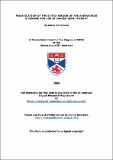Modification of the E1-pIX region of the adenovirus 5 genome for use in cancer gene therapy
Abstract
Currently the use of adenoviruses in cancer gene therapy is limited by efficient
delivery of the virus into the tumour cells, detargeting of the virus from the liver, and
the efficient spread of the virus within the tumour. Rapid and easy modification of
adenoviruses enables expression of different genes from the genome of an oncolytic
virus. I developed a system where the E1-pIX region of the adenovirus 5 genome
could be mutated via recombination of a recipient virus with the deleted E1-pIX
region flanked by a loxP and an attB-site and an “addback” plasmid with the mutated
E1-pIX region flanked by a loxP and an attP-site. The recipient virus was found not to
be producible even on a pIX-complementing cell line. The pIX was further modified
by fusing GFP, FCU1 and MMP7 to the C-terminus with a 2A sequence that enables
the ribosome to skip one specific peptide bond enabling the expression of genes
flanking this sequence. Two different 2A sequences were used: FMDV 2A (F2A) and
PTV-1 2A (P2A). The pIX-P2A-GFP expressing virus was found to have similar heat
stability, CPE, burst size and plaque size characteristics as the parental virus, whereas
the pIX-F2A-GFP expressing virus was found to have reduced heat stability, CPE,
burst size and smaller plaque size. The viruses expressing FCU1 and MMP7 were
found only to be producible on a pIX-complementing cell line due to the low
expression of pIX from these constructs. I concluded that 2A sequences can be used
in the context of adenoviruses but optimisation of the sequence may be needed
depending on the fusion partners.
Type
Thesis, MPhil Master of Philosophy
Collections
Items in the St Andrews Research Repository are protected by copyright, with all rights reserved, unless otherwise indicated.

